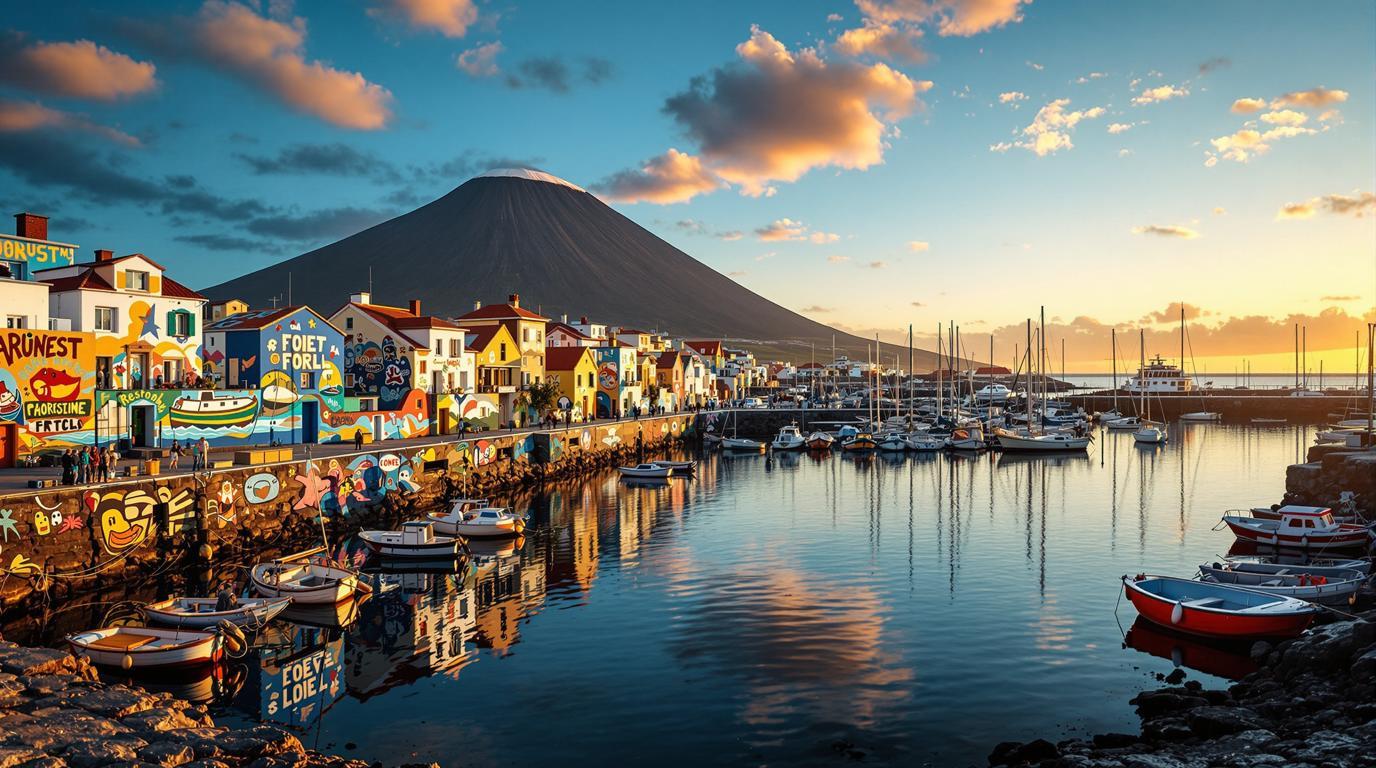Deep in the Atlantic Ocean, where cerulean waters meet volcanic majesty, lies Faial Island — the “Blue Island” of Portugal’s Azores archipelago. This 67-square-mile paradise isn’t just another pretty Portuguese outpost; it’s where nature performs its most dramatic acts daily. The island’s striking beauty comes from an extraordinary combination: hydrangea-covered hills cascading toward black sand beaches, all crowned by a massive volcanic crater that whispers stories of Earth’s fiery past.
The island where sailors leave their mark
In Horta, Faial’s charming port town, thousands of colorful murals adorn the marina walls — a tradition dating back decades. Superstitious sailors believe painting a mural ensures safe onward passage. This living art gallery changes constantly as new vessels arrive, making it among the most unique maritime traditions anywhere in the Atlantic.
“If you don’t leave your mark at Horta’s marina, the sea goddesses will surely bring you bad luck on your journey,” explains Miguel Azevedo, a local sailing instructor whose family has welcomed ocean travelers for three generations.
A massive crater houses a hidden ecosystem
The crown jewel of Faial is unquestionably Caldeira do Cabeço Gordo, a massive volcanic crater measuring 2 kilometers across and 400 meters deep. This verdant depression isn’t just visually stunning — it’s an ecological sanctuary housing over 60% of the Azores’ endemic plant species. The rim trail offers jaw-dropping panoramic views that rival Arizona’s most stunning natural formations, though with an entirely different color palette.
Where Earth grew 1.5 square miles overnight
Capelinhos Volcano created one of the most fascinating landscapes you’ll ever witness. When it erupted in 1957-58, the volcano literally expanded Portugal’s territory, adding 1.5 square miles of new land to the western edge of Faial. Today, the area resembles a lunar landscape where visitors can walk across terrain younger than most of its visitors.
Peter’s Café Sport: A legendary sailors’ haven
For over 100 years, this blue-façaded establishment has welcomed sailors from every corner of the globe. More than just a café, it’s a cultural institution where weathered captains share tales of ocean adventures over the bar’s famous gin and tonics. The café even houses a scrimshaw museum upstairs, showcasing intricate whale teeth carvings that tell the island’s whaling history.
Whale watching with purpose
Once a whaling powerhouse, Faial has transformed its relationship with cetaceans. The same lookout points formerly used to spot whales for hunting now serve conservation-minded tourism. Visitors can witness sperm whales, dolphins, and even blue whales during migration season — an experience that rivals Japan’s most magical wildlife encounters.
The island that doesn’t fear climate chaos
With its moderate Atlantic climate and sustainable approach to resources, Faial represents an unexpected haven in uncertain environmental times. The island’s commitment to renewable energy and self-sufficient agriculture makes it reminiscent of climate-resilient communities worldwide.
“We’ve always lived with the understanding that we must respect what nature provides,” says Elena Medeiros, a local environmental guide. “When you’re surrounded by ocean on a volcanic rock, you learn quickly that sustainability isn’t optional.”
The underground beach you won’t find elsewhere
Praia do Porto Pim offers more than just golden sands. Adjacent to this picturesque bay sits the former Whaling Factory, now transformed into a fascinating museum. Unlike ancient ruins that hide entire villages, this industrial complex conceals stories of Faial’s complex relationship with the ocean’s greatest mammals.
A connection to a neighboring giant
From almost anywhere on Faial, the imposing silhouette of Pico Mountain looms across the channel — a perfect volcanic cone rising 7,713 feet above sea level. This visual relationship between the islands creates a sense of intimate connection, similar to how tiny Mediterranean islands relate to their larger neighbors.
Beyond picture-perfect vistas
Faial isn’t just visually stunning — it’s a living testament to humanity’s resilience in the face of nature’s mighty forces. Here, volcanic catastrophe transformed into opportunity, whaling history evolved into conservation, and isolation bred not desperation but innovation. This Atlantic jewel doesn’t just captivate visitors with its beauty; it reminds us that even the most remote places on Earth have profound lessons to teach about adaptation, sustainability, and finding harmony with our planet.
